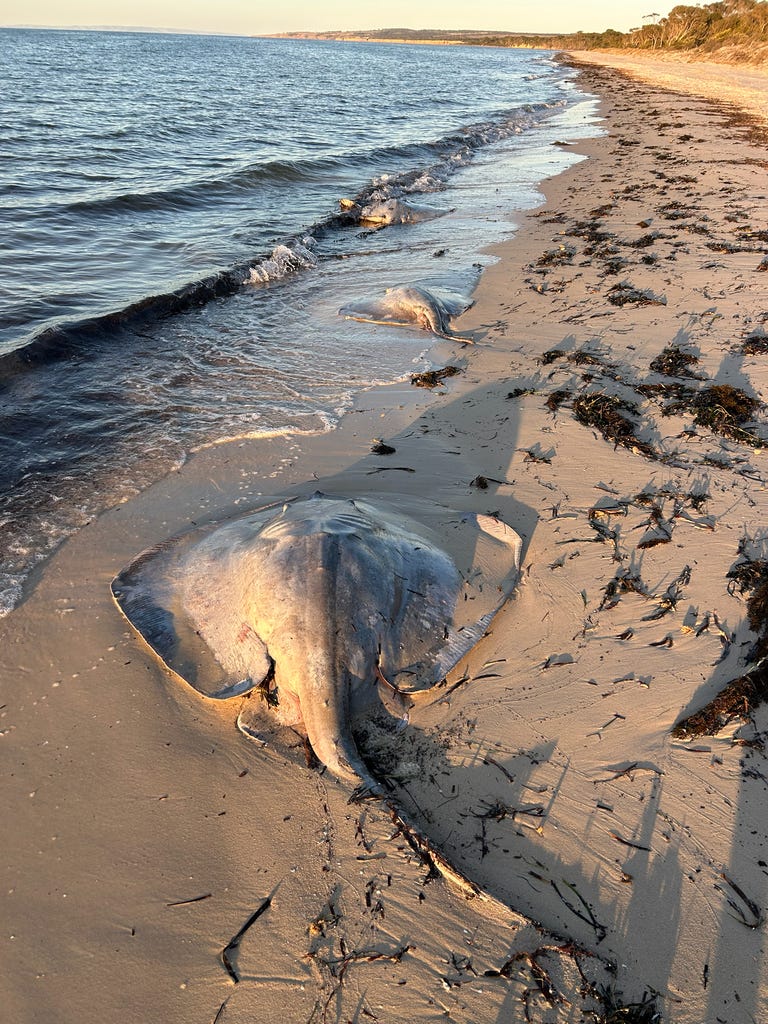They poisoned the sea. Now the ocean can’t breathe.
What’s happening in South Australia is a warning to the world.
Since mid-March 2025, South Australia's coastal waters have been experiencing an unprecedented ecological disaster. The coastlines were transformed into graveyards for marine life. We have been receiving images every day from people all around South Australia, and decided to deep dive into this.
A massive bloom of the toxic algae Karenia mikimotoi has led to widespread marine life deaths, with over 200 species affected, including fish, sharks, rays, and invertebrates.
The bloom's impact wasn't limited to marine life. Beachgoers reported respiratory issues, blurred vision, and skin irritations after exposure to the contaminated waters. The situation was so dire that authorities closed multiple beaches, including Waitpinga and Parsons, to protect public health.
Scroll down to read the full story.
The algae: Karenia mikimotoi
Karenia mikimotoi is a dinoflagellate known for producing toxins that are lethal to fish and invertebrates. This microscopic killer suffocates marine life by depleting oxygen and releasing toxins, leading to mass die-offs and even causing respiratory issues in humans exposed to the contaminated sea spray.
This isn't South Australia's first encounter with K. mikimotoi. A similar bloom occurred in Coffin Bay in 2014, causing widespread fish and invertebrate deaths. However, this event's scale and severity are unprecedented.
The perfect storm: The climate crisis and the fishing industry
If you’re looking for a villain in this story, don’t stop at rising temperatures.
Yes, the ocean is heating. Yes, rainfall patterns are shifting. And yes, the climate crisis is supercharging extreme events like marine heatwaves and floods. But blaming just the climate crisis is like blaming a match for a wildfire—without asking who doused the forest in gasoline.
The fishing industry didn’t just watch this disaster unfold. It helped engineer it.
South Australia’s coastline is home to massive aquaculture operations—industrial fish farms pumping out thousands of tonnes of waste, uneaten feed, antibiotics, and excrement straight into the sea. These nutrient bombs create perfect conditions for harmful algal blooms: the ocean equivalent of a sewer-fed swamp.
Combine that with warming waters, disrupted ocean currents, and an overfished ecosystem that’s lost its natural resilience? You’ve got a biological ticking time bomb.
And when the explosion happens—when the oxygen vanishes and the fish start floating—what does the industry say?
“Unusual.”
“Unexplained.”
“Under investigation.”
This isn’t unexplained. It’s what happens when profit is prioritised over balance, when delicate ecosystems are treated like production lines.
Industrial fishing strips the ocean of life, fish farms turn pristine bays into slurry pits, and climate change lights the match. Together? It’s not just a perfect storm. It’s collapse, manufactured.
How this affects bigger animals — not just those feeding on algae
It’s easy to scroll past news of dead anchovies and sardines washing up on the shore — to see it as an isolated die-off, another footnote in a warming world. But this isn’t just a story of small fish.
This is a breakdown of the entire food web.
When low-oxygen zones take over marine environments it doesn’t just choke out algae feeders. It suffocates everything that breathes.
Imagine trying to breathe in a room slowly filling with carbon monoxide. That’s what happens to marine animals when algal blooms deplete oxygen: the gills stop working. The heart rate spikes. And then? Silence.
And the ones that don’t die immediately? They’re weakened, underfed, or driven from their habitats. Seals abandon rookeries. Sharks vanish from traditional hunting grounds. Whales that migrate to feed on rich baitfish aggregations find only dead zones.
When the small fish die off in vast numbers, larger marine animals either starve or move, throwing entire ecosystems out of balance.
What You Can Do
What is happening in South Australia is a warning for coastlines everywhere.
And while governments stall and industry spins its PR machine, we can’t afford to wait. Here's what you can do right now:
Stay sharp. Don’t let “natural causes” become the lazy excuse. Share this story. Talk about the real drivers: pollution, fish farms, and climate chaos feeding off each other.
Raise your voice. Contact your local MPs, environmental agencies, and councils in South Australia (and beyond). Ask why industrial fish farms are still allowed to dump waste into ecosystems already gasping for breath.
Document everything. If you're local and see something off—dead fish, murky water, sick animals—report it. Tag it. Film it. Post it. Public pressure starts with proof.
Vote like the ocean depends on it. Because it does. Demand bans on fish farms in vulnerable areas. Demand real climate action. Demand marine protection that actually protects.
If we let industries turn the sea into a sacrifice zone, mass die-offs will become the new normal.
Stay loud, stay informed, stay active.









